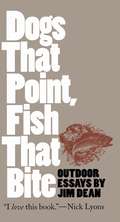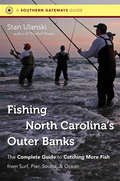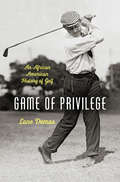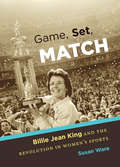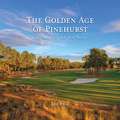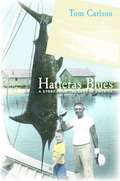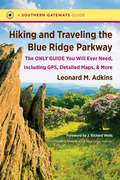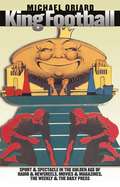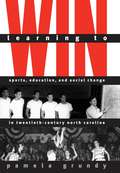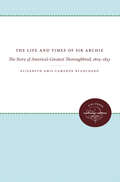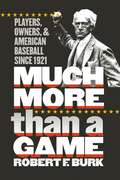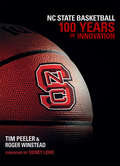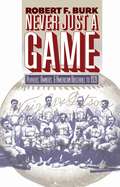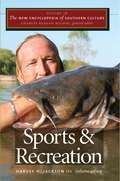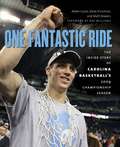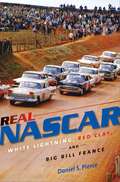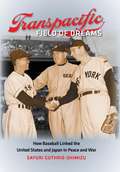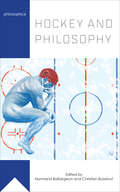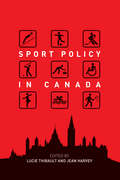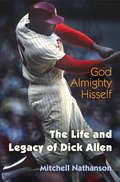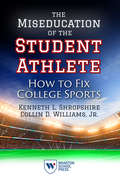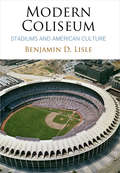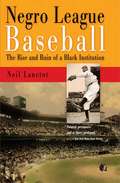- Table View
- List View
Dogs That Point, Fish That Bite
by Jim DeanJim Dean, longtime editor of Wildlife in North Carolina, offers his personal observations on the pleasures and frustrations of hunting, fishing, camping, and other outdoor pursuits. Dogs That Point, Fish That Bite draws together fifty of the best columns that Dean has written for the magazine over the last seventeen years. The witty, sometimes poignant pieces are arranged into a loose chronicle of the sporting year, with a generous allowance for digression: the first is set in April, on the opening day of trout season, and the last tells of a New Year's Day spent alone in a mountain cabin. At first glance, hunting and fishing are the focus of most of the columns. Often, however, Dean is after bigger game. A crab that escapes the pot leads him to reflect on the capricious nature of life. The restoration of a cabin at the old family farm evokes memories of family and simpler times. And a May panfishing trip takes on the quality of ritual, performed by two old friends. The consistent theme uniting all the essays is the celebration of wild places and rural traditions that have become endangered in our modern world."Earthy, intimate, brilliant, and always wise, these outdoor essays spring from the heart and mind of a replete hunter and fisherman. Jim Dean is among the top few writer-sportsmen in America--and I love this book.--Nick Lyons, author of Confessions of a Fly-Fishing Addict "Jim Dean brings you his outdoors with long experience, pleasant sentiment and unforgettable wry humor. His hunting, fishing and camping life may have centered in his beloved North Carolina but his pilgrimages to other fields and waters have spiced his stories with memorable comparisons. His book will last.--Charles F. Waterman, author of Black Bass and the Fly Rod Jim Dean, longtime editor of Wildlife in North Carolina, shares his personal observations on the pleasures and frustrations of hunting, fishing, camping, and other outdoor pursuits in this gem of a book. Dogs That Point, Fish That Bite draws together fifty of Dean's best essays, arranged into a loose chronicle of the sporting year--from the opening day of trout season to a New Year's Day spent alone in a mountain cabin. A witty and sometimes poignant collection, it celebrates the wild places and rural traditions that have become endangered in our modern world.-->
Fishing North Carolina's Outer Banks
by Stan UlanskiIn this hands-on, how-to guide to fishing North Carolina's Outer Banks, expert fisherman Stan Ulanski combines his enthusiasm, his experience, and his scientific expertise to show anglers how to catch more fish. Focusing on the essential but often misunderstood links between recreational fishing and the biology, geography, and natural history of the region,Fishing North Carolina's Outer Banksfosters an understanding of the aquatic environment of one of the nation's prime fishing destinations. Ulanski reveals the best approaches to the six main Outer Banks angling scenarios: surf, pier, sound, offshore, inshore, and reef, ledge, and shipwreck fishing. The book features illustrated fish profiles--each loaded with essential information, including identification, food value, and habitat pointers--and species-specific fishing tips for thirty-five of the Outer Banks' most common game fish. And, once you've made your catch, Ulanski provides important storing, cleaning, and cooking advice--including six of his favorite fresh fish recipes. This is a trusty tacklebox tool for planning fishing trips to the Outer Banks and for understanding the underwater setting of the fish you're out to catch.
Game of Privilege: An African American History of Golf (The John Hope Franklin Series in African American History and Culture)
by Lane DemasThis groundbreaking history of African Americans and golf explores the role of race, class, and public space in golf course development, the stories of individual black golfers during the age of segregation, the legal battle to integrate public golf courses, and the little-known history of the United Golfers Association (UGA)--a black golf tour that operated from 1925 to 1975. Lane Demas charts how African Americans nationwide organized social campaigns, filed lawsuits, and went to jail in order to desegregate courses; he also provides dramatic stories of golfers who boldly confronted wider segregation more broadly in their local communities. As national civil rights organizations debated golf's symbolism and whether or not to pursue the game's integration, black players and caddies took matters into their own hands and helped shape its subculture, while UGA participants forged one of the most durable black sporting organizations in American history as they fought to join the white Professional Golfers' Association (PGA). From George F. Grant's invention of the golf tee in 1899 to the dominance of superstar Tiger Woods in the 1990s, this revelatory and comprehensive work challenges stereotypes and indeed the fundamental story of race and golf in American culture.
Game of Privilege: An African American History of Golf (The John Hope Franklin Series in African American History and Culture)
by Lane DemasThis groundbreaking history of African Americans and golf explores the role of race, class, and public space in golf course development, the stories of individual black golfers during the age of segregation, the legal battle to integrate public golf courses, and the little-known history of the United Golfers Association (UGA)--a black golf tour that operated from 1925 to 1975. Lane Demas charts how African Americans nationwide organized social campaigns, filed lawsuits, and went to jail in order to desegregate courses; he also provides dramatic stories of golfers who boldly confronted wider segregation more broadly in their local communities. As national civil rights organizations debated golf’s symbolism and whether or not to pursue the game’s integration, black players and caddies took matters into their own hands and helped shape its subculture, while UGA participants forged one of the most durable black sporting organizations in American history as they fought to join the white Professional Golfers’ Association (PGA). From George F. Grant’s invention of the golf tee in 1899 to the dominance of superstar Tiger Woods in the 1990s, this revelatory and comprehensive work challenges stereotypes and indeed the fundamental story of race and golf in American culture.
Game, Set, Match: Billie Jean King and the Revolution in Women's Sports
by Susan WareWhen Billie Jean King trounced Bobby Riggs in tennis's "Battle of the Sexes" in 1973, she placed sports squarely at the center of a national debate about gender equity. In this winning combination of biography and history, Susan Ware argues that King's challenge to sexism, the supportive climate of second-wave feminism, and the legislative clout of Title IX sparked a women's sports revolution in the 1970s that fundamentally reshaped American society. While King did not single-handedly cause the revolution in women's sports, she quickly became one of its most enduring symbols, as did Title IX, a federal law that was initially passed in 1972 to attack sex discrimination in educational institutions but had its greatest impact by opening opportunities for women in sports. King's place in tennis history is secure, and now, withGame, Set, Match, she can take her rightful place as a key player in the history of feminism as well. By linking the stories of King and Title IX, Ware explains why women's sports took off in the 1970s and demonstrates how giving women a sporting chance has permanently changed American life on and off the playing field.
The Golden Age of Pinehurst
by Lee PaceOne of the finest golf courses in America in the early 1900s was the revered Pinehurst No. 2, designed by the legendary Donald Ross and first opened in 1907. Physically and mentally demanding, the course gave players options on every hole and required them to envision and execute recovery shots from the sandy perimeters and the pine forests as well as think creatively around the intricate greens. As a result, No. 2 became a favorite of the nation's top amateurs and professionals. Unfortunately, a modernization of the course over the last four decades stripped it of much of its character. In The Golden Age of Pinehurst, Lee Pace chronicles the breathtaking restoration of No. 2 from its recent slick and monochromatic presentation back to a natural potpourri of hardpan sand, wire grass, and Sandhills pine needles. The restored No. 2--accessible for amateur play, yet challenging enough for the professional--once again stands apart for its beauty, strategic appeal, and Old World flavor.
Good Walks: Rediscovering the Soul of Golf at Eighteen of the Carolinas' Best Courses
by Lee PaceThis book celebrates the beauty, tradition, and variety of golf across the Carolinas, featuring eighteen beloved courses as experienced by the walking golfer. One of golf's earliest appeals was its health-giving benefits, with players walking some four miles over varied terrain, making stamina and endurance an important part of the sport. Most recreational players today choose motorized carts. But Lee Pace believes that the slower pace and on-the-ground view associated with walking gives one an opportunity to savor the experience, understand the nuances of course design and landscape architecture, and appreciate the small touches that make our region's best clubs and courses special. The Carolinas are a cradle for the game in the United States, making walking its courses an ideal way to connect past and present. Attractively illustrated with full-color photography, each essay tells the story of a course and how it is experienced on foot. Guiding readers around fabled courses like Pinehurst No. 2 and new classics like Kiawah Island's Ocean Course, private clubs and municipal courses, resort destinations and urban gems, Pace reflects on legendary course architects, famous tournaments, notable players, ties between the game's founders and the Carolinas, and more. Whether you're a committed traditionalist or new to the game, this book will inspire you to slow down and enjoy the best of what golf has to offer.
Hatteras Blues
by Tom CarlsonTom Carlson tells the story of Ernal Foster and the Foster family of Hatteras Village, who gave birth to what would become the multi-million dollar charter fishing industry on the Outer Banks. Today, Ernal's son, Captain Ernie Foster, struggles to keep the family business alive in a time of great change on the Banks. Within the engaging saga of the rise and decline of one family's livelihood, Carlson relates the history and transformation of Hatteras Village and the high-adrenaline experience of blue-water sportfishing and the industry that surrounds it. Hatteras Blues is their story--a story of triumph and loss, of sturdy Calvinist values and pell-mell American progress, and of fate and luck as capricious as the weather.
Hiking and Traveling the Blue Ridge Parkway
by Leonard M. Adkins J. Richard WellsThis comprehensive guidebook provides a detailed description of every official trail along the Blue Ridge Parkway. But that's just the beginning: veteran hiker Leonard M. Adkins includes information on every trail that touches the Parkway, including the Appalachian Trail, the Mountains-to-Sea Trail, and other public pathways on national park, state park, national forest, municipal, and private lands. You'll find GPS coordinates for official Parkway trailheads, along with fifty maps and many photographs of what you'll see along the way. Adkins notes each trail's length, difficulty, points of interest, handicap accessibility, and natural features. Far more than a guide to the trails, this book also tells you what to expect at overlooks, as well as where to dine, sleep, and find a restroom, and suggests worthwhile side trips. Elevation change charts for bicyclists, minimum tunnel heights for RVs, camping recommendations, roadside bloom calendars, sightseeing information for nearby towns, and other advice make this the perfect companion for your next Parkway adventure.
King Football
by Michael OriardThis landmark work explores the vibrant world of football from the 1920s through the 1950s, a period in which the game became deeply embedded in American life. Though millions experienced the thrills of college and professional football firsthand during these years, many more encountered the game through their daily newspapers or the weekly Saturday Evening Post, on radio broadcasts, and in the newsreels and feature films shown at their local movie theaters. Asking what football meant to these millions who followed it either casually or passionately, Michael Oriard reconstructs a media-created world of football and explores its deep entanglements with a modernizing American society.Football, claims Oriard, served as an agent of "Americanization" for immigrant groups but resisted attempts at true integration and racial equality, while anxieties over the domestication and affluence of middle-class American life helped pave the way for the sport's rise in popularity during the Cold War. Underlying these threads is the story of how the print and broadcast media, in ways specific to each medium, were powerful forces in constructing the football culture we know today."[Oriard] captures the self-aggrandizing illogic of the game's cultural role in his absorbing study of early 20th-century culture.--New York Times"This excellent book should be required reading on any American Studies course worth the name. . . . Oriard's detailed and well-written work shows us how the game has been constructed through notions of national, gendered and ethnic--and, as he insists, also class--identities.--Journal of American StudiesIn this landmark work exploring the vibrant world of football from the 1920s through the 1950s, Michael Oriard explores how the mass media shaped and were shaped by the exploding popularity of football. King Football is at once a sweeping cultural history of football, a provocative study of the power of print and broadcast media, and a compelling investigation of American attitudes about race, class, and gender and their relationship to sport.-->
Learning to Win
by Pamela GrundyOver the past century, high school and college athletics have grown into one of America's most beloved--and most controversial--institutions, inspiring great loyalty while sparking fierce disputes.In this richly detailed book, Pamela Grundy examines the many meanings that school sports took on in North Carolina, linking athletic programs at state universities, public high schools, women's colleges, and African American educational institutions to social and economic shifts that include the expansion of industry, the advent of woman suffrage, and the rise and fall of Jim Crow. Drawing heavily on oral history interviews, Grundy charts the many pleasures of athletics, from the simple joy of backyard basketball to the exhilaration of a state championship run. She also explores conflicts provoked by sports within the state--clashes over the growth of college athletics, the propriety of women's competition, and the connection between sports and racial integration, for example. Within this chronicle, familiar athletic narratives take on new meanings, moving beyond timeless stories of courage, fortitude, or failure to illuminate questions about race, manhood and womanhood, the purpose of education, the meaning of competition, and the structure of American society.
The Life and Times of Sir Archie: The Story of America's Greatest Thoroughbred, 1805-1833
by Elizabeth Amis Blanchard Manly Wade WellmanFew Americans triumphed more gallantly over odds, wore honors more gracefully, or were so honestly mourned after death than Sir Archie, forefather of such great horses as Man O'War, Gallant Fox, War Admiral, and Native Dancer. The depiction of the antebellum life of which Sir Archie was a part is as colorful and exciting as his career.Originally published in 1958.A UNC Press Enduring Edition -- UNC Press Enduring Editions use the latest in digital technology to make available again books from our distinguished backlist that were previously out of print. These editions are published unaltered from the original, and are presented in affordable paperback formats, bringing readers both historical and cultural value.
Much More Than a Game
by Robert F. BurkTo most Americans, baseball is just a sport; but to those who own baseball teams--and those who play on them--our national pastime is much more than a game. In this book, Robert Burk traces the turbulent labor history of American baseball since 1921. His comprehensive, readable account details the many battles between owners and players that irrevocably altered the business of baseball. During what Burk calls baseball's "paternalistic era," from 1921 to the early 1960s, the sport's management rigidly maintained a system of racial segregation, established a network of southern-based farm teams that served as a captive source of cheap replacement labor, and crushed any attempts by players to create collective bargaining institutions. In the 1960s, however, the paternal order crumbled, eroded in part by the civil rights movement and the competition of television. As a consequence, in the "inflationary era" that followed, both players and umpires established effective unions that successfully pressed for higher pay, pensions, and greater occupational mobility--and then fought increasingly bitter struggles to hold on to these hard-won gains.
NC State Basketball 100 Years of Innovation
by Tim Peeler Roger WinsteadIn this fascinating official history of the first 100 years of the North Carolina State University men's basketball program, Tim Peeler and Roger Winstead recount the traditions and innovations that have shaped Wolfpack basketball as well as the history and customs of college basketball itself. In a nation once dominated by football and baseball, visionary coaches from NC State--Gus Tebell, Everett Case, Norm Sloan, and Jim Valvano--helped push basketball to the forefront of the national imagination, igniting a passion and excitement for the game that made the Atlantic Coast Conference the center of the college sports universe. This book, with 230 captivating photographs, showcases the many college basketball traditions made famous at NC State, including cutting down the nets, spotlighting players during introductions, and even the alley oop. All the legendary players and unique personalities that have passed through the doors of Thompson Gymnasium, Reynolds Coliseum, and the RBC Center are here, from Ronnie Shavlik and David Thompson to Sidney Lowe and Julius Hodge. With two national championships, 17 conference championships, and countless memorable moments, NC State Basketball remains one of college basketball's proudest programs. Wolfpack fans and college basketball lovers alike will find much to celebrate in this enthralling history.
Never Just a Game
by Robert F. BurkAmerica's national pastime has been marked from its inception by bitter struggles between owners and players over profit, power, and prestige. In this book, the first installment of a highly readable, comprehensive labor history of baseball, Robert Burk describes the evolution of the ballplaying work force: its ethnocultural makeup, its economic position, and its battles for a place at the table in baseball's decision-making structure. In the late nineteenth and early twentieth centuries, the growing popularity of baseball as a spectator sport and the dramatic upsurge of America's urban population created conditions that led to franchise competition, the development of rival leagues, and trade wars, in turn triggering boom-and-bust cycles, franchise bankruptcies, and league mergers. According to Burk, players repeatedly tried to use these circumstances to better their economic positions by playing one team off against another. Their successes proved short-lived, however, because their own internal divisions, exploited by management, undercut attempts to create collective-bargaining institutions. By 1920, owners still held the upper hand in the labor-management battle, but as today's sports pages show, owners did not secure a long-term solution to their labor problems."Burk proves that when it comes to baseball's money issues, the more things change--the more they stay the same.--USA Today Baseball Weekly "A lively, highly readable volume filled with fascinating anecdotes. . . . The book will appeal to both the serious student of business history and the layman with merely an interest in the game itself.--Business History America's national pastime has been marked from its inception by bitter struggles between owners and players over profit, power, and prestige. In this labor history of baseball from its beginning to 1920, Robert Burk describes the evolution of the ballplaying work force and recounts its battles for a place in baseball's decision-making structure. Tracing the development of franchise competition, rival leagues, and trade wars--and the boom-and-bust cycles, franchise bankruptcies, and league mergers they triggered in turn--he explores the off-field acrimony that characterized the sport's labor-management relations. -->
The New Encyclopedia of Southern Culture: Sports and Recreation
by Harvey H. JacksonWhat southerners do, where they go, and what they expect to accomplish in their spare time, their "leisure," reveals much about their cultural values, class and racial similarities and differences, and historical perspectives. This volume of The New Encyclopedia of Southern Culture offers an authoritative and readable reference to the culture of sports and recreation in the American South, surveying the various activities in which southerners engage in their nonwork hours, as well as attitudes surrounding those activities.Seventy-four thematic essays explore activities from the familiar (porch sitting and fairs) to the essential (football and stock car racing) to the unusual (pool checkers and a sport called "fireballing"). In seventy-seven topical entries, contributors profile major sites associated with recreational activities (such as Dollywood, drive-ins, and the Appalachian Trail) and prominent sports figures (including Althea Gibson, Michael Jordan, Mia Hamm, and Hank Aaron). Taken together, the entries provide an engaging look at the ways southerners relax, pass time, celebrate, let loose, and have fun.
One Fantastic Ride
by Adam Lucas Matt Bowers Steve KirschnerOne Fantastic Ride is a behind-the-scenes portrait of the unforgettable journey to the University of North Carolina's 2009 basketball national championship, the program's fifth NCAA Tournament title. Adam Lucas, Steve Kirschner, and Matt Bowers were with the Tar Heels every step of the way, interviewing coaches, players, and staff. As the 2008-09 season opened, national pundits widely considered the Tar Heels the hands-down favorite to win the title. But injuries to key players, surprising midseason losses, and formidable ACC competition made the ride bumpier than expected. In the crucial last month of the season, however, a veteran team drew on their experience--and subtle adjustments by coaches and players--to achieve the goal they'd set for themselves after their disappointing defeat in the 2008 Final Four. More than just a season-in-the-life of a perennially excellent program, this book captures the crowning achievement of a senior class that exemplified the proud tradition of Carolina Basketball, both on and off the court. They became the most decorated class in UNC Basketball history while enjoying every aspect of their Tar Heel experience.With "Thoughts for the Day" taken directly from Carolina Basketball practice plans and more than 200 color photographs, this book is a unique keepsake for fans everywhere. Full of insights from players and coaches, One Fantastic Ride takes an intimate look at how the Tar Heels pulled it all together to come out on top.
Real NASCAR
by Daniel S. PierceIn this history of the stock car racing circuit known as NASCAR, Daniel Pierce offers a revealing new look at the sport from its postwar beginnings on Daytona Beach and Piedmont dirt tracks through the early 1970s when the sport spread beyond its southern roots and gained national recognition. Following NASCAR founder Big Bill France from his start as a mechanic, Real NASCAR details the sport's genesis as it has never been shown before. Pierce not only confirms the popular notion of NASCAR's origins in bootlegging, but also establishes beyond a doubt the close ties between organized racing and the illegal liquor industry, a story that readers will find both fascinating and controversial.Drawing on the memories of a variety of participants--including highly colorful characters like Lloyd Seay, Roy Hall, Gober Sosebee, Smokey Yunick, Bunky Knudsen, Humpy Wheeler, Bobby Isaac, Junior Johnson, and Big Bill France himself--Real NASCAR shows how the reputation for wildness of these racers-by-day and bootleggers-by-night drew throngs of spectators to the tracks in the 1930s, '40s, and '50s. They came to watch their heroes maneuver ordinary automobiles at incredible speed, beating and banging on each other, wrecking spectacularly, and fighting out their differences in the infield.Although France faced many challenges--including a fickle Detroit that often seemed unsure of its support for the sport, safety issues that killed star drivers and threatened its very existence, and drivers who twice tried to unionize to gain a bigger piece of the NASCAR pie--by the early 1970s France and his allies had laid a firm foundation for what has become today a billion-dollar industry and arguably the largest spectator sport in America.
Transpacific Field of Dreams
by Sayuri Guthrie-ShimizuBaseball has joined America and Japan, even in times of strife, for over 150 years. After the "opening" of Japan by Commodore Perry, Sayuri Guthrie-Shimizu explains, baseball was introduced there by American employees of the Japanese government tasked with bringing Western knowledge and technology to the country, and Japanese students in the United States soon became avid players. In the early twentieth century, visiting Japanese warships fielded teams that played against American teams, and a Negro League team arranged tours to Japan. By the 1930s, professional baseball was organized in Japan where it continued to be played during and after World War II; it was even played in Japanese American internment camps in the United States during the war.From early on, Guthrie-Shimizu argues, baseball carried American values to Japan, and by the mid-twentieth century, the sport had become emblematic of Japan's modernization and of America's growing influence in the Pacific world. Guthrie-Shimizu contends that baseball provides unique insight into U.S.-Japanese relations during times of war and peace and, in fact, is central to understanding postwar reconciliation. In telling this often surprising history, Transpacific Field of Dreams shines a light on globalization's unlikely, and at times accidental, participants.
Hockey and Philosophy (Philosophica)
by Normand Baillargeon and Christian BoissinotDoes hockey provide a better understanding of the differences between Canadian and Québécois nationalisms? Is there a fundamental relationship between the hockey arena and the political arena? What have we lost as a society in abolishing the tie game? Are salaries in the NHL really that outrageous? Is hockey more art than sport? Should hockey players be banned from using performance-enhancing drugs at all costs? Do goalies suffer from angst? Does our national sport have its own mythology and metaphysics? Do hockey brawls reflect our true human nature more than we would care to admit? And what would it be like if the great philosophers were to face off on the ice? A team of philosophy and hockey buffs go deep with these fascinating questions and many others in this examination of a worshipped sport elevated to something akin to a cult. Accessibly written and peppered with humour, the essays in this book will charm specialists, sports fans, and everyone in between. Whether you’re a fan of Richard, Gretzky, Crosby, Plato, Kant, or Kierkegaard, you’re invited to be a spectator at this very special meeting of minds!
Sport Policy in Canada (Open Access)
by Lucie Thibault and Jean HarveySport Policy in Canada provides the first and most comprehensive analysis of the new Canadian Sport Policy adopted in 2012. In light of this new policy, the authors, top scholars in the field, provide detailed accounts of the most salient sport policies and programs, while also discussing issues and challenges facing policy makers. In Canada and around the world, the last decades have known a sharp increase in state intervention and public funding in pursuit of medals on the international stage and in support of a more active lifestyle. Governments at all levels have made substantial investments in hope of hosting major sporting events to benefit from the economic impact and gain international prestige.The study of sport policies, often neglected in the past, is becoming an increasingly important research topic. Sport Policy in Canada seeks to fill this void by offering the most comprehensive analysis of sport policy since Macintosh, Bedecki, and Franks' Sport Policy in Canada (1987). - This book is published in English.
God Almighty Hisself
by Mitchell NathansonWhen the Philadelphia Phillies signed Dick Allen in 1960, fans of the franchise envisioned bearing witness to feats never before accomplished by a Phillies player. A half-century later, they're still trying to make sense of what they saw. Carrying to the plate baseball's heaviest and loudest bat as well as the burden of being the club's first African American superstar, Allen found both hits and controversy with ease and regularity as he established himself as the premier individualist in a game that prided itself on conformity. As one of his managers observed, "I believe God Almighty hisself would have trouble handling Richie Allen. " A brutal pregame fight with teammate Frank Thomas, a dogged determination to be compensated on par with the game's elite, an insistence on living life on his own terms and not management's: what did it all mean? Journalists and fans alike took sides with ferocity, and they take sides still. Despite talent that earned him Rookie of the Year and MVP honors as well as a reputation as one of his era's most feared power hitters, many remember Allen as one of the game's most destructive and divisive forces, while supporters insist that he is the best player not in the Hall of Fame. God Almighty Hisself: The Life and Legacy of Dick Allen explains why. Mitchell Nathanson presents Allen's life against the backdrop of organized baseball's continuing desegregation process. Drawing out the larger generational and business shifts in the game, he shows how Allen's career exposed not only the racial double standard that had become entrenched in the wake of the game's integration a generation earlier but also the forces that were bent on preserving the status quo. In the process, God Almighty Hisself unveils the strange and maddening career of a man who somehow managed to fulfill and frustrate expectations all at once.
The Miseducation of the Student Athlete: How to Fix College Sports
by Kenneth L. Shropshire Collin D. Williams Jr.The student-athlete’s life: practice, gym, weight room, film review, repeat. Simply put, sports come first. Academics is a distant second. As the revenues generated by big-time college sports continue to skyrocket, virtually all of the debate involves whether (and how much) student-athletes should be paid for play. Kenneth L. Shropshire and Collin D. Williams, Jr., argue that ”student” has to come first in student-athlete: the focus should be on prioritizing a meaningful education.In The Miseducation of the Student Athlete: How to Fix College Sports, Shropshire and Williams draw on new research to reveal that it has become increasingly difficult for college athletes to balance school and sports, much less a social life, leading to serious economic, professional, and emotional consequences for young people. Given that fewer than 2% of all college men’s basketball and football players will play at the professional level, the other 98% of student-athletes must be prepared to find and perform well in jobs outside of their respective field of play.In this bold call to action, Shropshire and Williams explain how we got here and what can be done about it. They lay out The Student-Athlete Manifesto, a roadmap to increase the likelihood that student-athletes can succeed both on and off the field. They also offer a Meaningful Degree Model, which ensures education pays for everyone, along with stories of success that show it is possible to be both a student and an athlete.A critical read for student-athletes, sports leadership, policy makers, and anyone who loves college sports, The Miseducation of the Student Athlete has the potential to disrupt college sport and create lasting change.
Modern Coliseum: Stadiums and American Culture
by Benjamin D. LisleFrom the legendary Ebbets Field in the heart of Brooklyn to the amenity-packed Houston Astrodome to the "retro" Oriole Park at Camden Yards, stadiums have taken many shapes and served different purposes throughout the history of American sports culture. In the early twentieth century, a new generation of stadiums arrived, located in the city center, easily accessible to the public, and offering affordable tickets that drew mixed crowds of men and women from different backgrounds. But in the successive decades, planners and architects turned sharply away from this approach.In Modern Coliseum, Benjamin D. Lisle tracks changes in stadium design and culture since World War II. These engineered marvels channeled postwar national ambitions while replacing aging ballparks typically embedded in dense urban settings. They were stadiums designed for the "affluent society"—brightly colored, technologically expressive, and geared to the car-driving, consumerist suburbanite. The modern stadium thus redefined one of the city's more rambunctious and diverse public spaces.Modern Coliseum offers a cultural history of this iconic but overlooked architectural form. Lisle grounds his analysis in extensive research among the archives of teams, owners, architects, and cities, examining how design, construction, and operational choices were made. Through this approach, we see modernism on the ground, as it was imagined, designed, built, and experienced as both an architectural and a social phenomenon. With Lisle's compelling analysis supplemented by over seventy-five images documenting the transformation of the American stadium over time, Modern Coliseum will be of interest to a variety of readers, from urban and architectural historians to sports fans.
Negro League Baseball: The Rise and Ruin of a Black Institution
by Neil LanctotThe story of black professional baseball provides a remarkable perspective on several major themes in modern African American history: the initial black response to segregation, the subsequent struggle to establish successful separate enterprises, and the later movement toward integration. Baseball functioned as a critical component in the separate economy catering to black consumers in the urban centers of the North and South. While most black businesses struggled to survive from year to year, professional baseball teams and leagues operated for decades, representing a major achievement in black enterprise and institution building.Negro League Baseball: The Rise and Ruin of a Black Institution presents the extraordinary history of a great African American achievement, from its lowest ebb during the Depression, through its golden age and World War II, until its gradual disappearance during the early years of the civil rights era. Faced with only a limited amount of correspondence and documents, Lanctot consulted virtually every sports page of every black newspaper located in a league city. He then conducted interviews with former players and scrutinized existing financial, court, and federal records. Through his efforts, Lanctot has painstakingly reconstructed the institutional history of black professional baseball, locating the players, teams, owners, and fans in the wider context of the league's administration. In addition, he provides valuable insight into the changing attitudes of African Americans toward the need for separate institutions.
